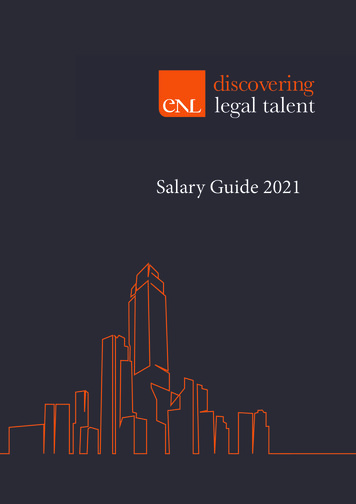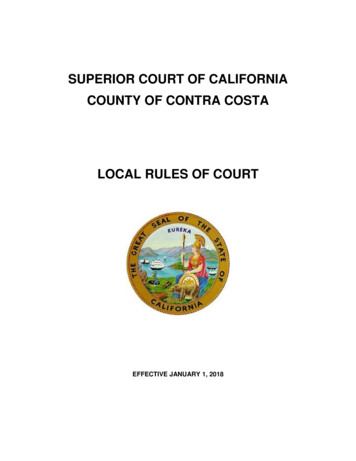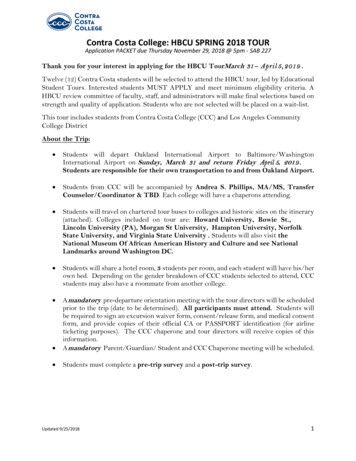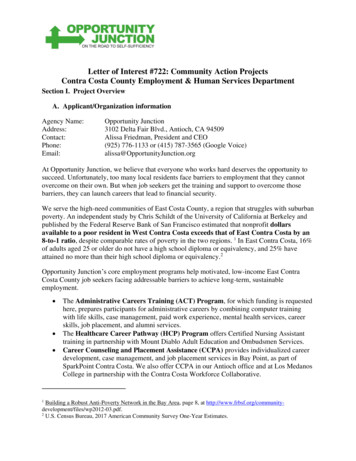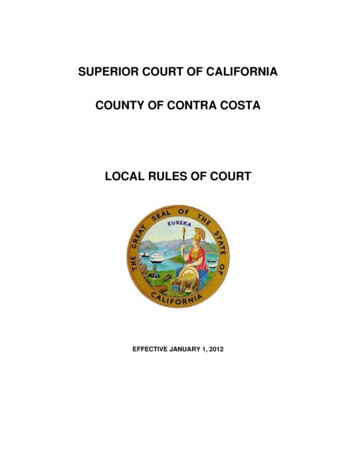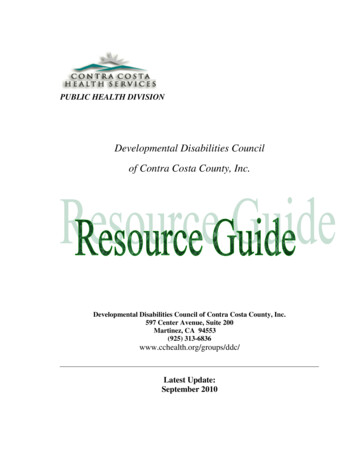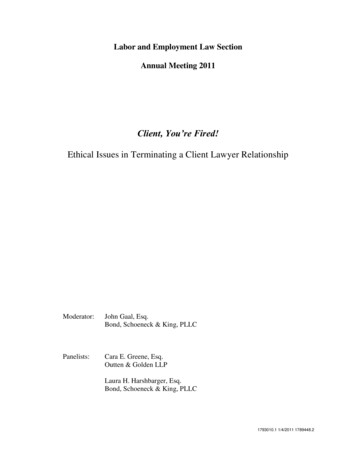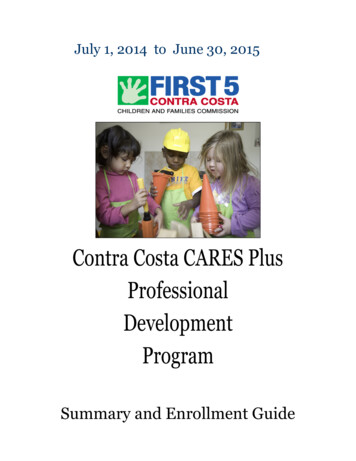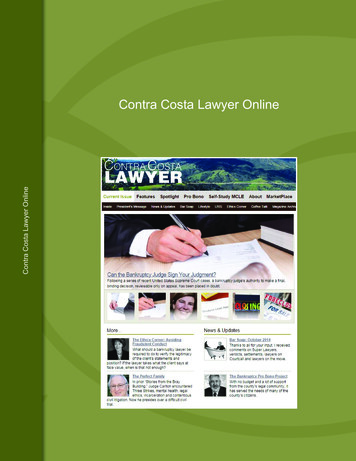
Transcription
Contra Costa Lawyer OnlineContra Costa Lawyer Online
The Contra Costa Lawyer is the official publication of the ContraCosta County Bar Association (CCCBA), published 12 times a year in six print and 12 online issues.1
2
ContentsGuest Editor's Column, October 20144What to Do if Your Civil Litigation Client Files Bankruptcy7Can the Bankruptcy Judge Sign Your Judgment?11An Interview with Chapter 13 Trustee Martha Bronitsky14Recent Developments in Student Loans and Bankruptcy18Commercial Tenants Who File Bankruptcy22Sham Guaranty Defense and the Effect of Lawlor25California’s “Right to Repair Act” Is Not the Exclusive Remedyfor .28Equity (and Equity Stripping) is Back32The Real Story About the LA Stip36Bar Soap: October 201438The Ethics Corner: Avoiding Fraudulent Conduct41The Bankruptcy Pro Bono Project43The Perfect Family45Register Today for the 2014 MCLE Spectacular49Lisa Reep’s Retirement Party [photos]51Coffee Talk: What is your favorite local restaurant and why?523
Guest Editor's Column, October 2014Wednesday, October 01, 2014This month’s Contra Costa Lawyer is dedicated to bankruptcy and litigation. As many ofyou undoubtedly know through experience, these two areas of law do not always existentirely independently, but interact with each other in many and varied ways. Thisintersection, of bankruptcy and litigation, is a big part of what we are focusing on thismonth.To paraphrase a popular series of commercials sometimes you are at the corner of “Ihave a great case I am working on,” and “Oh no! My client just filed bankruptcy!” What doyou do? You open up David Schuricht’s article, for starters. There is a lot to consider,from how you will get paid for the work you have already done, to whether you cancontinue representing your client without permission, and this article can help you getorganized.You may find yourself needing the bankruptcy judge to enter a judgment for your litigated4Contra Costa Lawyer Online
case. Can you do that? Corrine Bielejeski’s article takes a close look at this question(Spoiler the answer is more complicated than it seems—read more to find out why).An interview that should be of interest to both bankruptcy attorneys and litigators whomight find themselves in Bankruptcy Court (with a client, of course), is David Arietta’sinterview with Martha Bronitsky, the Chapter 13 standing trustee who oversees everyChapter 13 case filed in the Oakland Division of the Northern District of CaliforniaBankruptcy Court. In addition to giving you insight into her background and the way heroffice works, Ms. Bronitsky offers tidbits of advice to both bankruptcy attorneys whopractice with her office regularly AND to state court attorneys who might find themselvesworking with her office for the first time.There is a new movement to make higher education more affordable. U.S. News evendid a ranking of colleges based on “value” this value). This new look at the value of college has taken place in an era ofincreasingly burdensome student loans. One question that many people are asking iswhether those loans are dischargeable in bankruptcy and, if so, how does one go aboutdoing that? Scott Jordan’s article addresses this question.What happens when your client is the landlord of a commercial building and his tenantsfile bankruptcy? What are your rights as the landlord? Who owns the real propertylocated on the premises? These are just some of the questions Vahishta Falahatilconsiders in her article on commercial leases and bankruptcy.Next, Steve Knuppel takes a look at the ability of a guarantor to invoke the shamguarantee and a creditor’s ability, in essence, to obtain a deficiency judgmentnotwithstanding the California anti-deficiency rules.We continue our focus on bankruptcy issues, in both our Pro Bono Spotlight and in ourEthics Corner. In the Pro Bono Spotlight, Alan Ramos tells us about the Bankruptcy ProBono Project here in Contra Costa County: How it started, how it has grown and how itcontinues to help the residents of the county. Meanwhile, Carol Langford looks at thequestion of exactly how much (and what kind of) advice we can give our clients inbankruptcy (particularly advice about asset protection) without violating our ethical dutiesagainst advising clients to commit fraudulent acts.Not all litigation intersects with bankruptcy. Sometimes a litigated case is just a litigatedcase, and so we have articles focusing on various aspects of litigation.Construction defect is a large area of litigation. What, exactly, are the homeowners’remedies when discovering a construction defect that has not caused actual damage tothe property (even if it may have caused economic damages)? What about where thedefect has caused actual damages? Is the homeowner limited to the remedies set out inSB 800 (construction defect)? Brian Seibel takes a look at this question and recentdevelopments around SB 800.With the improvements in the economy and recovery in our real estate markets, morepeople are getting back to having equity in their homes. Unfortunately, that good newscomes with bad—more equity means more equity stripping, particularly among theelderly. Craig Nevin takes a closer look at this issue and offers a host of possibleremedies for those who may have been victimized.Contra Costa Lawyer Online5
Practicing in Northern California is very different than practicing in Southern California, formany reasons. One of those reasons is the “LA Stip.” Although it is used in SouthernCalifornia regularly, it is not something used in Northern California practice. Have youever wondered about this difference? If so, make sure to read “The Real Story about theLA Stip" by Wendy Graves, where she explains the history of the LA Stip and discusseswhy it is used in Southern California litigation practice.Now that we have just filled our minds with all of this wonderful substance, maybe it’stime to read something a little less heavy. Want to be “in the know” with what is going onwith our local attorneys? Matt Guichard has another installment of Bar Soap that is justfilled with news and happenings.Maybe you prefer some good fiction? We are proud to publish another installment of theJudge Carlton stories by Justice Marchiano (Ret). “The Perfect Family” takes a look at awrongful death action in which everything is not as perfect as it may seem at first.Last, but not least, a big THANK YOU to our two guest editors this month, MarleneWeinstein and Craig Nevin, who both gave generously of their time and expertise tomake this issue happen.Marlene G. Weinstein is a sole practitioner whose practice is devoted exclusively toBankruptcy Law representing debtors, creditors and Chapter 7 trustees. She has alsorecently been appointed as a Chapter 7 panel trustee. She believes pre-bankruptcyplanning is important and that it can sometimes be used as an effective tool innegotiations between parties involved in non-bankruptcy disputes. Marlene often workswith her clients in conjunction with their family law, tax, litigation and other nonbankruptcy attorneys. Her office is in Walnut Creek and she can be reached at (925) 4720800.Formerly Associate General Counsel for a major real estate developer in Irvine, for over25 years, Craig Nevin has provided litigation and transactional counsel to owners,developers, financial institutions, contractors, subcontractors and other companies incomplex business, real estate, construction and development related matters. He haspresented numerous seminars concerning real estate, construction, development, salesand mortgages, as well as litigation management and avoidance. Mr. Nevin is on theBoard of Directors and current Chair of Contra Costa Senior Legal Services and on theAdvisory Board of Directors of The Law Center.6Contra Costa Lawyer Online
What to Do if Your Civil Litigation Client FilesBankruptcyWednesday, October 01, 2014You’re a litigator representing a plaintiff or a defendantin a lawsuit in Superior Court. One day, you learn thatyour client, either in propia persona or through othercounsel, has filed a bankruptcy petition. What shouldyou do? The answer depends partly on whether yourclient is a plaintiff (or cross-complainant) or adefendant (or cross-defendant) in the lawsuit,although some considerations are common to bothsituations, and in either case, the answer definitely isnot to continue with the litigation as though nothinghas changed. Here are some pointers:Impact of the Automatic StayIf you represent a defendant or cross-defendant whohas filed bankruptcy, chances are that the litigation (orthe part in which your client is a defendant) is stayed by the bankruptcy filing. See 11U.S.C § 362[1] respecting the scope and effect of the “automatic stay,” including the(relatively few) exceptions to its applicability. If your case is stayed, you should file andserve a notice of stay (explaining that the case is stayed by your client’s bankruptcy) inthe court where the litigation is pending.Unless your case fits within one of the exceptions, the automatic stay prohibits theprosecution of the action against the defendant debtor until the stay terminates or thebankruptcy court makes an order granting “relief from stay” that permits the action toproceed. Unless the plaintiff’s claim is nondischargeable,[2] if your client eventuallyreceives a bankruptcy discharge, the discharge permanently enjoins the plaintiff fromcontinuing or commencing an action to recover the claim from your debtor client as apersonal liability.[3]What if the plaintiff obtains an order “granting relief from stay” from the bankruptcy court,allowing the plaintiff to continue prosecuting the litigation in state court? If that happensand you are going to continue as debtor’s counsel in the litigation, then you’ll want to payattention to the points discussed below, especially the points about getting youremployment approved by, and your fees and other charges allowed by, the bankruptcycourt.Causes of Action that Become Property of the BankruptcyEstateIf your client is a plaintiff or cross-complainant, you need to be aware that: (1) theautomatic stay does not stay a proceeding that was initiated by the debtor;[4] and (2) thecause of action you have been prosecuting is now, in all likelihood, property of thebankruptcy estate.[5]When you have been representing the debtor in prosecuting a cause of action that nowContra Costa Lawyer Online7
has become property of the debtor’s bankruptcy estate, it is a good idea (particularly ifyour client is in pro per in the bankruptcy case) to remind your client that the cause ofaction needs to be scheduled (listed) as an asset on Schedule B (a list of the debtor’spersonal property) in the bankruptcy case.While the existence of the lawsuit will certainly come to light if the bankruptcy court isasked to approve your employment for the purpose of prosecuting it (see below), somedebtors may not realize that the cause of action is an asset that needs to be scheduledas such in the bankruptcy—and the failure to schedule an asset can come back to bite adebtor who might assume, after a Chapter 7 case is closed without the cause of action inquestion having been “administered” by the trustee, that the lawsuit again belongs to himor her.If the cause of action bears fruit later and wasn’t scheduled, the trustee may be able totake it (or its proceeds) even long after the bankruptcy case is closed. In some cases,judicial estoppel has been successfully asserted as a defense to a claim after a debtor’sfailure to schedule it in the bankruptcy case.Need for Approval of Counsel’s Employment andCompensationThe employment (or retention) of an attorney to represent the bankruptcy estate (i.e., torepresent a Chapter 7 bankruptcy trustee, a Chapter 13 debtor or a Chapter 11 debtor-inpossession or trustee[6]) in state court generally requires the bankruptcy court’sapproval.[7] If you represent a plaintiff who has filed bankruptcy, you’ll probably want tocontact the bankruptcy estate’s representative (the trustee in a Chapter 7 case or in aChapter 11 case where a trustee has been appointed; and the debtor—your client—or,better yet, your client’s bankruptcy counsel, in a Chapter 13 case or in a Chapter 11where there is no trustee), to find out whether the bankruptcy estate wishes to retain youas counsel to continue to prosecute the lawsuit in state court.If you delay in applying to the bankruptcy court for approval of your retention by thebankruptcy estate, you will be “at risk” of not getting paid for any legal services you mayprovide between the time the bankruptcy petition was filed and the time your employmentis approved. If you fail to get bankruptcy court approval, you probably won’t be paid foryour services, at least not by the bankruptcy estate.In addition, in most situations, your charges (both fees and expense reimbursement)must be approved by the bankruptcy court before you can be paid.[8] This means that anapplication for compensation will have to be filed and set for hearing in the bankruptcycourt and that you will be entitled to receive payment only to the extent your application isapproved.[9]Extension of DeadlinesRespecting deadlines, you should know that federal bankruptcy law (Code § 108)extends certain deadlines for the trustee (or—in a Chapter 13 case or in a Chapter 11where no trustee has been appointed—the debtor) to file any pleading, notice or demandin a state court action, provided the relevant deadline did not expire before thebankruptcy petition was filed.8Contra Costa Lawyer Online
Removal to the Bankruptcy CourtFederal law confers upon state court litigants the right to remove to federal court (inpractice, this usually means to the bankruptcy court, which is an “arm” of the districtcourt) most civil actions “related to” a bankruptcy case.[10] If the debtor in a bankruptcycase is a party to state court litigation, it’s a safe bet that the litigation is “related to” thebankruptcy and is a candidate for removal.[11] Whether to remove a cause of action orresist removal by an adverse party, can, of course, be an important tactical questioninvolving a number of factors.Need for Approval of SettlementsDon’t forget that when you are representing an estate representative, any settlement orcompromise will need to be approved by the bankruptcy court before it will bind yourclient.[12] Be sure to make the adverse party aware of this when you are involved insettlement negotiations, and always include a term in the settlement agreement makingthe settlement contingent on bankruptcy court approval.Accounts Receivable for Prepetition Legal ServicesFinally, if you have unpaid billings based on services you provided before the bankruptcywas filed, don’t forget that the automatic stay applies to you, the same as to any othercreditor. Once your client has filed a bankruptcy petition, you can’t demand that thedebtor bring your billings for prepetition fees current. You may be able to keep the fundsin your trust account depending on when the funds were deposited and when the fees tobe paid were incurred.You may want to file a timely proof of claim in the bankruptcy case for the amount of youroutstanding prepetition charges if you want to receive a distribution from the estate, butthere are some potentially adverse consequences of doing so.[13]Finally, unless the debtor voluntarily enters into a reaffirmation agreement with you thatcomplies with the strict requirements of Code § 524(c) & (d), your client’s debt to you forpre-filing services will very likely be discharged if your client receives a discharge in thebankruptcy case–even if you continue to provide services to your client after thebankruptcy case is closed.While all of these issues deserve further discussion, it is hoped that this article will putyou on the right path toward determining what you should do when your litigation clientmorphs into a bankruptcy debtor.David Schuricht is a partner in the Walnut Creek law firm of Katzen & Schuricht, wherehis practice focuses on bankruptcy law. Mr. Schuricht is a 1974 graduate of Boalt HallSchool of Law, and he has been actively practicing in California for nearly 40 years.[1] Unless otherwise indicated, all subsequent statutory references in this article are toTitle 11 of the United States Code ( “Code”).[2] See Code § 523 & 1328.[3] Code § 524(a).Contra Costa Lawyer Online9
[4] Brown v. Armstrong, 949 F.2d 1007 (8th C. 1991).[5] See Code § 541.[6] Chapter 9 (municipality) and Chapter 12 (family farmer) bankruptcy cases arerelatively rare (at least, with respect to Chapter 12, in our area), so they aren’t furthermentioned in this article.[7] Code § 327.[8] Code § 330.[9] Id. FRBP 2016.[10] See 28 U.S.C. §§ 1334 & 1452.[11] A.H. Robins Co. v. Piccinin, 788 F.2d 994, 1002, ftnt. 11 (4th C. 1986) questioned onother grounds in Chord Assocs., LLC vs. Protech 2003-D. LLC 2010 U.S. Dist. LEXIS28465 (E.D.N.Y. 2010); LSM Hotel, LLC vs. Serhan (In re LSM Hotel, LLC), 2011 Bankr.LEXIS 635 (B.C.S.D. Cal. 2011).[12] See Federal Rule of Bankruptcy Procedure (“FRBP”) 9019.[13] See FRBP 3002 & 3003.10Contra Costa Lawyer Online
Can the Bankruptcy Judge Sign Your Judgment?Wednesday, October 01, 2014Congratulations! The bankruptcy judge just signed anorder in your client’s favor after a hard-foughtadversary proceeding. After calling your client, youcelebrate and put your feet up. At least, that’s whatyou did in the old days. Now, you worry.Following a series of recent United States SupremeCourt cases, a bankruptcy judge’s authority to make afinal, binding decision, reviewable only on appeal, hasbeen placed in doubt. This article will explain theissues, update you on the case law, and provide somesuggestions going forward.Let’s start at the beginning. Congress set bankruptcyjudges apart by only giving them limited authority. 28U.S.C. §157 delineates when a bankruptcy judge canenter orders (core) and when matters have to be sent to the District Court instead (noncore). As a practical matter, though, parties often consented to stay in the BankruptcyCourt, even when a District Court judge could have heard the matter.[1] District Courtjudges also favored bankruptcy matters staying with the bankruptcy judges, issuinggeneral orders and rules placing these cases squarely before their colleagues.Stern v. MarshallThen came Stern v. Marshall, 564 U.S. , 131 S.Ct. 2594 (2011). One litigant, not likingthe bankruptcy judge’s ruling, argued that the judge lacked the authority to enter a finalbinding order.[2] In a five to four decision, the Supreme Court agreed with him. It held thatwhile Congress clearly gave bankruptcy judges the authority to hear the matter, thatstatute was not enough.[3] Article III of the Constitution put that authority solely in thehands of District Court judges who, unlike bankruptcy judges, enjoy lifetime appointmentsand wage guarantees.[4]Worried that the opinion could sound like bankruptcy judges had no authority at all, ChiefJustice Roberts narrowly tailored the holding to say that bankruptcy judges lack theauthority to enter final orders only where a “state law counterclaim is not resolved inthe process of ruling on a creditor’s proof of claim.”[5] Narrow holding or not, this case stillcaused a huge guessing game over judicial authority. Eventually a consensus wasreached. The Supreme Court had limited its decision to a particular type of claim, nowdubbed Stern claims, so everything else could continue as normal. For those Sternclaims, local rules were promulgated to clear up the confusion.However, these rules did not completely clear up the picture. For example, what wereStern claims? If a bankruptcy judge thought a case involved Stern claims, should thebankruptcy judge issue findings of fact and conclusions of law, like he or she did for noncore cases, or simply send those cases on to the District Court? Also, if both partiesconsent to a bankruptcy judge entering a final order on a Stern claim, does that cure theconstitutional problem?Contra Costa Lawyer Online11
Executive Benefits aka In re: BellinghamMindful of these open questions, the Supreme Court took on the case of ExecutiveBenefits Insurance Agency v. Arkison, Chapter 7 Trustee of Estate of BellinghamInsurance Agency, also known in bankruptcy circles as In re: Bellingham.[6] ExecutiveBenefits argued that the Bankruptcy Court lacked the authority to hear the trustee’sfraudulent conveyance action, as it was a Stern claim. It also argued that the DistrictCourt’s de novo review of the bankruptcy judge’s order did not cure the initialdeficiency.[7] The Supreme Court disagreed.On June 9, 2014, a unanimous Supreme Court declared that bankruptcy judges couldtreat Stern claims like non-core proceedings—hearing cases and issuing findings of factand conclusions of law for review and entry of final order by the District Court.[8] It alsoruled that de novo review by the District Court saved the order, even if it wasn’ttechnically a finding of fact initially sent over for the District Court judge’s review andsignature.[9]Our local judges must be psychic, as this is exactly what they provided for in DistrictCourt General Order 24: “The district court may treat any order of the bankruptcy court asproposed findings of fact and conclusions of law in the event the district court concludesthat the bankruptcy judge could not have entered a final order or judgment consistentwith Article III of the United States Constitution.”[10]Now it is clear that bankruptcy judges can hear these matters, even if the District Courtmay have to sign off on them. It also appears that de novo review by the District Court willcure an authority deficiency. I can hear you asking about the first question that ExecutiveBenefits raised, about whether fraudulent conveyance claims are Stern claims. JusticeThomas brushed past that saying “the Court of Appeals held, and we assume withoutdeciding, that the fraudulent conveyance claims in this case are Stern claims.”[11] Healso stated that the court would come back to the consent issue.[12]Wellness InternationalWith those questions remaining, the Supreme Court has accepted Wellness InternationalNetwork v. Sharif, case number 13-935, for review this term. Certiorari was granted onJuly 1, 2014, with the petitioners’ brief due September 9, 2014, and respondent’s briefdue November 19, 2014. As of the date this article was written, a date had not yet beenset for oral argument. Wellness International should decide the question of consent, bothexplicit and implied, when the court hears it. It may also further define Stern claims.So what does this mean for you and your client? The good news is yes, the bankruptcyjudge can hear your case. If it’s a core proceeding, the District Court would prefer if youallowed the bankruptcy judge to hear the case and issue findings of fact, but you canalways file a request for withdrawal of reference to have the District Court hear it.[13]What if both parties consent to have the bankruptcy judge hear a Stern claim? That’s stillunclear, but in footnote 8 of the Executive Benefits decision, the court indicated it was notinterested in “dramatically alter[ing] the division of responsibility set by Congress.”[14] Iwill go on the record as saying actual consent grants bankruptcy judges constitutionalauthority, since they already have subject-matter jurisdiction. However, there is a split inthe Circuits, so we’ll have to wait another year to see if I’m right.12Contra Costa Lawyer Online
Corrine Bielejeski is the owner of East Bay Bankruptcy Law, which received a Best ofAntioch 2014 award from the Antioch Chamber of Commerce. She clerked for the Hon.Edward D. Jellen in the Oakland Bankruptcy Court, before entering private practice. Sheis a Past Co-Chair of the Bankruptcy Court’s Bench-Bar Liaison Committee and invitesthe bar to contact her with any problems or suggestions that can be brought to the court’sattention. Corrine can be reached at (925) 752-1826.[1] §157(c)(2).[2] Id. at 2601.[3] Id. at 2608.[4] Id. at 2601[5] Id. at 2620.[6] In re: Bellingham, 573 U.S. , 134 S.Ct. 2165 (2014).[7] Id. at 2175.[8] Id.[9] Id.[10] Gen. Order 24, §1.01 (c).[11] Id. at 2174.[12] Id. at 2170 n.4.[13] See 28 U.S.C. § 157(d), F.R.B.P. 5011, and Local Rule 5011-2. If you have aparticularly contentious opposing party, you might want to start with that.[14] 134 S.Ct. at 2173.Contra Costa Lawyer Online13
An Interview with Chapter 13 Trustee MarthaBronitskyWednesday, October 01, 2014David Arietta, Chair of CCCBA's Bankruptcy Law Section, met up with Martha G.Bronitsky to discuss her role serving as the Chapter 13 Standing Trustee for 20 years forthe United States Bankruptcy Court, Northern District of California, Oakland Division. Sheis responsible for all aspects of administering Chapter 13 cases filed in the OaklandBankruptcy Court. She has an office in Pleasanton, has 31 employees and oversees theoperation of an office that disburses approximately 40 million to creditors annually.Bronitsky attended Los Gatos High School in Los Gatos, California, and went on toattend college at UCLA. After graduation, she received her law degree from theUniversity of Maryland, Baltimore.14Contra Costa Lawyer Online
Tell us about your legal career before you became trustee.I started off handling misdemeanor jury and court trials at the San Mateo County DistrictAttorney’s Office. After a few years, I took on the challenge of becoming in-house legalcounsel for Home Savings of America. I was hired to be lead counsel for all bankruptcymatters in the Northern and Eastern districts of California. It was there that I first becameexposed to the bankruptcy field from the creditor’s perspective. I dealt with a lot of relieffrom stay matters and represented Home Savings in various bankruptcy cases. I wasalso litigation counsel on various matters in state and federal courts in NorthernCalifornia.So how did you end up being a Chapter 13 Trustee?A local attorney encouraged me to apply, as there was a vacancy due to the death ofPaul Wolfe, the then-Chapter 13 Trustee. The U.S. Trustee’s Office reviewedapproximately 400 applications and interviewed around 40 applicants. Fortunately, I wasselected and started my position in June 1995. Devin Durham-Berk also started as aChapter 13 Trustee around that time, but in the San Jose Division. We both received a lotof helpful mentoring from David Burchard, Chapter 13 Trustee, San Francisco Division,and Kathleen A. Leavitt, Chapter 13 Trustee, Las Vegas.This year is your twentieth year as a bankruptcy trustee.Can you highlight any interesting situations that you havedealt with?I remember one case early on. It was about 18 months after confirmation and the debtorfiled a motion to modify the Chapter 13 plan. I discovered that the debtor was hidingincome, and filed an objection. I prevailed at trial and got the case dismissed with a bar tofuture filings. At trial, the debtor’s attorney mentioned that the trustee never asked aboutincome at the meeting of creditors, to which Judge Jellen responded that bankruptcy isnot a game of “hide the football.”How do you spend a typical day as trustee?It depends, as I oversee two staff attorneys, four paralegals, and the rest of the staff. Ireview matters set for confirmation hearing. My staff prepares for confirmation hearingstwo weeks before and then I review the case one week before the hearing. We also havetwo meetings of creditors per month, which are prepped in a similar fashion. Either I orone of my staff attorneys handle the meetings of creditors. I hold regular meetings withmy attorneys, paralegals and case managers, and once a quarter with all my staff. A lotof time is spent dealing with day-to-day issues and questions that come up on cases.There are two things that I do every morning—the first is to review the bank records andverify what checks cleared, and the second is to review the filed notices of mortgagepayment changes.Contra Costa Lawyer Online15
Can you give any advice to bankruptcy attorneys whosecases your office regularly deals with and who appear incourt with you?Two words: “calendar management.” The less you touch the file, the more money you willmake. My office provides attorneys with a punch-list of things to do in every Chapter 13case well before the meeting of creditors. Too often, attorneys wait until the last minute toresolve issues that could have been timely addressed. The same thing applies toconfirmation hearings. Many matters can be resolved and taken off calendar well beforethe hearing date. There is a lot of work triggered on our end when there are continuedmeetings of creditors and matters set for confirmation. Additional advice would be tointerview and scope out your clients. Not every client is suitable for a Chapter 13bankruptcy. A client has had to have hit rock bottom and be on the upswing. Certainsituations are a recipe for disaster.Can you give any advice to state court attorneys whosometimes end up in bankruptcy court?In state court, you normally run into different attorneys in an assortment of counties anddepartments. In bankruptcy court, you will be in front of the same judges and normallysee the same attorneys in court. The worse thing to say is, “I do not know bankruptcylaw.” You can read the Bankruptcy Code and the local rules. Be polite with the judgesand the trustees. You can ask questions and there are discovery tools available.Remember that the “pie” is only so big; your client is not the only one who is owedmoney. If you get into a jam, consult with a bankruptcy attorney.Can you name some of your particular pet peeves? Whatcommon mistakes do you routinely see and what isparticularly bothersome to you?Attorneys who are non-responsive. My office sends out emails and notices on a regularbasis and there are those who
interview with Martha Bronitsky, the Chapter 13 standing trustee who oversees every Chapter 13 case filed in the Oakland Division of the Northern District of California Bankruptcy Court. In addition to giving you insight into her background and the way her office works, Ms. Bronitsky offers tidbits of advice to both bankruptcy attorneys who
